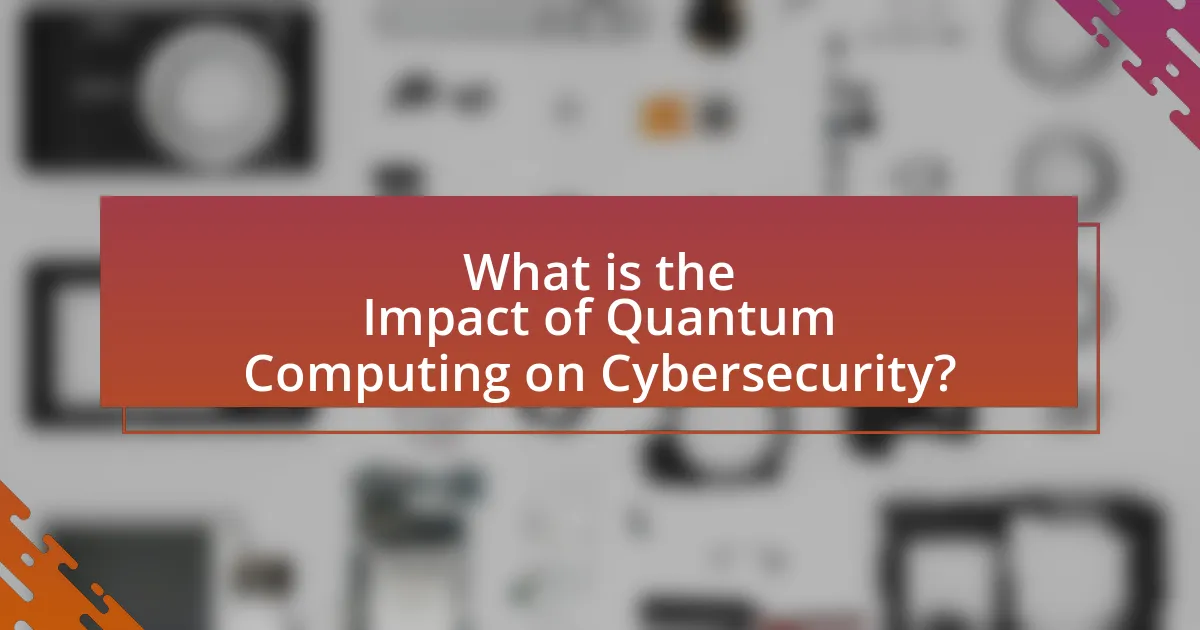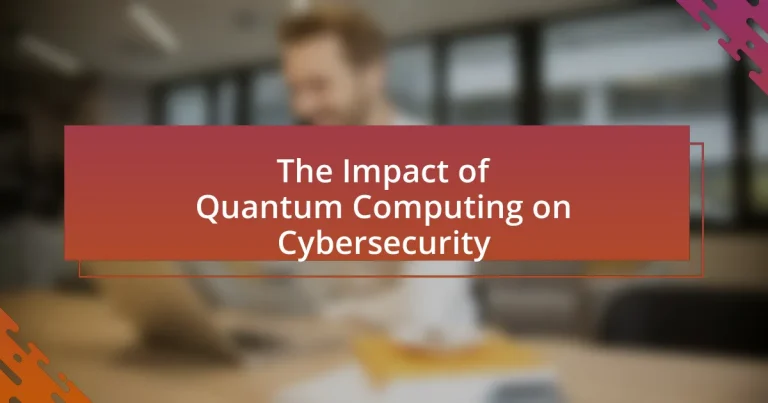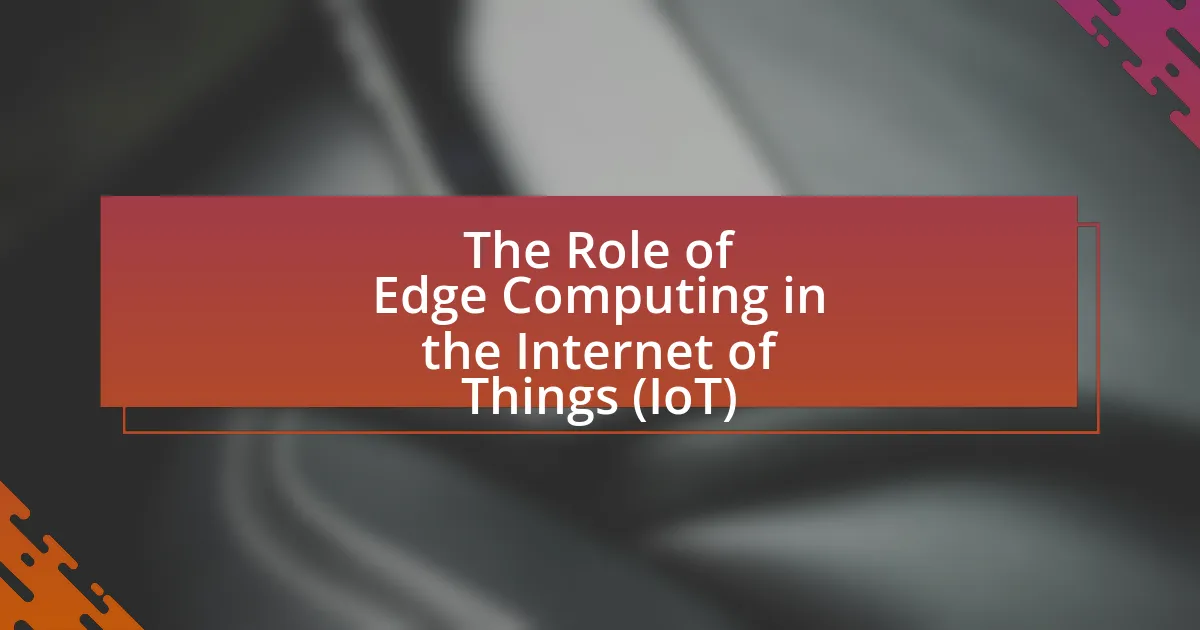Quantum computing represents a significant challenge to cybersecurity, primarily due to its potential to break widely used encryption methods such as RSA and ECC. Traditional encryption relies on mathematical problems that are difficult for classical computers to solve, but quantum algorithms like Shor’s algorithm can efficiently factor large integers and solve discrete logarithm problems, rendering these encryption methods vulnerable. The article explores the fundamental principles of quantum computing, the specific threats it poses to current cybersecurity measures, and the urgent need for organizations to adopt quantum-resistant cryptographic algorithms. Additionally, it discusses the role of quantum key distribution in enhancing security and outlines best practices for organizations to prepare for the impending quantum computing revolution in cybersecurity.

What is the Impact of Quantum Computing on Cybersecurity?
Quantum computing poses a significant threat to cybersecurity by potentially breaking widely used encryption methods. Traditional encryption algorithms, such as RSA and ECC, rely on the difficulty of factoring large numbers or solving discrete logarithm problems, which quantum computers can solve efficiently using algorithms like Shor’s algorithm. Research indicates that a sufficiently powerful quantum computer could decrypt sensitive data in seconds, undermining the security of communications and financial transactions. This capability necessitates the development of quantum-resistant cryptographic algorithms to safeguard data against future quantum attacks.
How does quantum computing differ from classical computing in the context of cybersecurity?
Quantum computing fundamentally differs from classical computing in cybersecurity by utilizing quantum bits (qubits) that can exist in multiple states simultaneously, enabling vastly superior processing power for certain tasks. This capability allows quantum computers to potentially break widely used encryption algorithms, such as RSA and ECC, which rely on the difficulty of factoring large numbers or solving discrete logarithms. For instance, Shor’s algorithm, designed for quantum computers, can factor large integers exponentially faster than the best-known classical algorithms, posing a significant threat to current cryptographic systems. As a result, the advent of quantum computing necessitates the development of quantum-resistant cryptographic methods to safeguard sensitive information against these emerging threats.
What are the fundamental principles of quantum computing that affect cybersecurity?
The fundamental principles of quantum computing that affect cybersecurity include superposition, entanglement, and quantum measurement. Superposition allows quantum bits (qubits) to exist in multiple states simultaneously, enabling quantum computers to process vast amounts of data more efficiently than classical computers. This capability poses a threat to traditional encryption methods, such as RSA, which rely on the difficulty of factoring large numbers; quantum algorithms like Shor’s algorithm can factor these numbers exponentially faster.
Entanglement creates a correlation between qubits, meaning the state of one qubit can depend on the state of another, regardless of the distance separating them. This principle can be utilized in quantum key distribution (QKD), which offers theoretically unbreakable encryption by ensuring that any eavesdropping attempts can be detected.
Quantum measurement collapses the superposition of qubits into a definite state, which can impact the security of data transmission. The act of measuring a quantum state can alter it, making it possible to detect unauthorized access.
These principles collectively indicate that quantum computing could render many current cybersecurity protocols obsolete, necessitating the development of quantum-resistant algorithms to safeguard sensitive information.
How does quantum computing challenge traditional encryption methods?
Quantum computing challenges traditional encryption methods primarily by enabling the efficient factorization of large integers and solving discrete logarithm problems, which are foundational to many encryption algorithms like RSA and ECC. Classical computers struggle with these tasks, making current encryption methods secure against conventional attacks. However, quantum algorithms, such as Shor’s algorithm, can perform these calculations exponentially faster, potentially breaking these encryption schemes in a feasible timeframe. Research indicates that a sufficiently powerful quantum computer could decrypt data secured by traditional methods within hours or days, undermining the security of sensitive information.
Why is understanding the impact of quantum computing on cybersecurity important?
Understanding the impact of quantum computing on cybersecurity is crucial because quantum computers have the potential to break traditional encryption methods that secure sensitive data. Current cryptographic algorithms, such as RSA and ECC, rely on the difficulty of factoring large numbers or solving discrete logarithm problems, which quantum algorithms like Shor’s algorithm can efficiently solve. This capability poses a significant threat to data integrity and confidentiality, as it could enable unauthorized access to encrypted communications and sensitive information. The urgency to comprehend this impact is underscored by the fact that organizations must adapt their cybersecurity strategies to mitigate risks associated with quantum advancements, ensuring the protection of critical infrastructure and personal data in a rapidly evolving technological landscape.
What potential threats does quantum computing pose to current cybersecurity measures?
Quantum computing poses significant threats to current cybersecurity measures by potentially breaking widely used encryption algorithms. Classical encryption methods, such as RSA and ECC, rely on the difficulty of factoring large numbers and solving discrete logarithm problems, respectively. Quantum computers, utilizing algorithms like Shor’s algorithm, can efficiently solve these problems, rendering traditional encryption methods insecure. Research indicates that a sufficiently powerful quantum computer could decrypt sensitive data in seconds, which poses risks to data confidentiality and integrity across various sectors, including finance and national security.
How can organizations prepare for the quantum computing revolution in cybersecurity?
Organizations can prepare for the quantum computing revolution in cybersecurity by adopting quantum-resistant cryptographic algorithms. These algorithms are designed to withstand the potential threats posed by quantum computers, which can break traditional encryption methods like RSA and ECC. For instance, the National Institute of Standards and Technology (NIST) is actively working on standardizing post-quantum cryptography, with the aim of providing secure alternatives that can protect sensitive data against quantum attacks. By transitioning to these new cryptographic standards, organizations can enhance their security posture and mitigate risks associated with quantum computing advancements.

What are the specific threats posed by quantum computing to cybersecurity?
Quantum computing poses specific threats to cybersecurity primarily through its ability to break widely used cryptographic algorithms. For instance, Shor’s algorithm enables quantum computers to factor large integers exponentially faster than classical computers, which threatens RSA encryption, a standard for securing sensitive data. Additionally, quantum computers can undermine elliptic curve cryptography, which is also prevalent in securing communications. The potential for quantum computers to perform these calculations in a feasible timeframe, as demonstrated by advancements in quantum technology, raises significant concerns about the future of data security and privacy.
How can quantum computers break existing encryption algorithms?
Quantum computers can break existing encryption algorithms by leveraging quantum algorithms, such as Shor’s algorithm, which efficiently factorizes large integers. Traditional encryption methods, like RSA, rely on the difficulty of factoring these large numbers, making them secure against classical computers. However, Shor’s algorithm can perform this task exponentially faster than the best-known classical algorithms, rendering RSA and similar encryption methods vulnerable. This capability has been demonstrated through theoretical analysis and simulations, indicating that once sufficiently powerful quantum computers are available, they could compromise widely used encryption standards, fundamentally altering the landscape of cybersecurity.
What are the most vulnerable encryption algorithms to quantum attacks?
The most vulnerable encryption algorithms to quantum attacks are RSA, DSA, and ECC. These algorithms rely on mathematical problems that quantum computers can solve efficiently using Shor’s algorithm, which can factor large integers and compute discrete logarithms in polynomial time. For instance, RSA’s security is based on the difficulty of factoring the product of two large prime numbers, a task that becomes feasible for quantum computers, rendering RSA insecure. Similarly, ECC, which relies on the difficulty of the elliptic curve discrete logarithm problem, is also compromised by quantum capabilities.
How does Shor’s algorithm specifically impact RSA and ECC encryption?
Shor’s algorithm significantly impacts RSA and ECC encryption by enabling efficient factorization of large integers and solving discrete logarithm problems, which are foundational to the security of these cryptographic systems. Specifically, RSA relies on the difficulty of factoring the product of two large prime numbers, while ECC’s security is based on the difficulty of solving the discrete logarithm problem in elliptic curves. Shor’s algorithm, when executed on a sufficiently powerful quantum computer, can perform these tasks in polynomial time, rendering traditional RSA and ECC encryption vulnerable to attacks. This potential for rapid decryption undermines the security assumptions that currently protect sensitive data, necessitating a shift towards quantum-resistant cryptographic algorithms to safeguard information in a post-quantum computing era.
What are the implications of quantum computing for data privacy?
Quantum computing poses significant implications for data privacy by potentially breaking current encryption methods. Traditional encryption algorithms, such as RSA and ECC, rely on the difficulty of factoring large numbers or solving discrete logarithm problems, which quantum computers can solve efficiently using algorithms like Shor’s algorithm. This capability threatens the confidentiality of sensitive data, as quantum computers could decrypt information that is currently secure. For instance, a sufficiently powerful quantum computer could compromise encrypted communications and stored data, leading to unauthorized access and data breaches. The urgency for developing quantum-resistant encryption methods is underscored by research from the National Institute of Standards and Technology, which is actively working on post-quantum cryptography standards to safeguard data privacy against future quantum threats.
How might quantum computing affect the confidentiality of sensitive information?
Quantum computing could significantly undermine the confidentiality of sensitive information by enabling the decryption of data that is currently considered secure. Traditional encryption methods, such as RSA and ECC, rely on the difficulty of factoring large numbers or solving discrete logarithm problems, which quantum computers can solve efficiently using algorithms like Shor’s algorithm. This capability poses a risk to sensitive data, as quantum computers could potentially break encryption keys in a fraction of the time it takes classical computers, thereby exposing confidential information. The National Institute of Standards and Technology (NIST) has recognized this threat and is actively working on post-quantum cryptography standards to mitigate the risks associated with quantum computing.
What measures can be taken to protect data privacy in a quantum computing era?
To protect data privacy in a quantum computing era, organizations should implement quantum-resistant cryptographic algorithms. These algorithms, such as lattice-based, hash-based, and code-based cryptography, are designed to withstand the computational power of quantum computers, which can break traditional encryption methods like RSA and ECC. Research by the National Institute of Standards and Technology (NIST) has identified several post-quantum cryptographic algorithms that are currently being standardized, ensuring that data remains secure against future quantum threats. Additionally, organizations should regularly update their security protocols and conduct risk assessments to adapt to evolving quantum technologies.

What are the potential solutions to mitigate the impact of quantum computing on cybersecurity?
To mitigate the impact of quantum computing on cybersecurity, organizations can adopt quantum-resistant cryptographic algorithms. These algorithms, such as lattice-based, hash-based, and code-based cryptography, are designed to withstand attacks from quantum computers, which can easily break traditional encryption methods like RSA and ECC. The National Institute of Standards and Technology (NIST) is actively working on standardizing post-quantum cryptography, with the aim of providing secure alternatives that can be implemented before quantum computers become widely available. Additionally, organizations should conduct regular security assessments and update their cryptographic protocols to ensure they are prepared for the evolving threat landscape posed by quantum technologies.
What is post-quantum cryptography and how does it work?
Post-quantum cryptography refers to cryptographic algorithms designed to be secure against the potential threats posed by quantum computers. These algorithms work by utilizing mathematical problems that are believed to be difficult for quantum computers to solve, such as lattice-based problems, hash-based signatures, and multivariate polynomial equations.
The security of traditional cryptographic systems, like RSA and ECC, relies on the difficulty of factoring large integers or solving discrete logarithm problems, which quantum computers could efficiently solve using algorithms like Shor’s algorithm. In contrast, post-quantum cryptographic algorithms are constructed to withstand such attacks, ensuring data integrity and confidentiality even in a future where quantum computing is prevalent.
What are the key features of post-quantum cryptographic algorithms?
Post-quantum cryptographic algorithms are designed to be secure against the potential threats posed by quantum computers. Key features of these algorithms include resistance to quantum attacks, reliance on mathematical problems that remain hard for quantum computers, and the ability to maintain security in a post-quantum world. For instance, lattice-based cryptography, one of the prominent approaches, is based on problems like the Shortest Vector Problem, which is believed to be difficult for both classical and quantum computers to solve. Additionally, these algorithms often emphasize efficiency and scalability to ensure they can be implemented in various systems without significant performance degradation.
How can organizations transition to post-quantum cryptography?
Organizations can transition to post-quantum cryptography by adopting quantum-resistant algorithms and updating their cryptographic infrastructure. This involves evaluating current cryptographic systems, selecting suitable post-quantum algorithms from standards being developed by organizations like NIST, and implementing these algorithms in their systems. For instance, NIST is in the process of standardizing post-quantum cryptographic algorithms, which provides a framework for organizations to follow. Additionally, organizations should conduct thorough testing and validation of these new algorithms to ensure compatibility and security before full deployment.
What role does quantum key distribution play in enhancing cybersecurity?
Quantum key distribution (QKD) plays a crucial role in enhancing cybersecurity by enabling secure communication through the principles of quantum mechanics. QKD allows two parties to generate a shared, secret key that is provably secure against eavesdropping, as any attempt to intercept the key would disturb the quantum states being transmitted, alerting the parties to the presence of an intruder. This security is underpinned by the laws of quantum physics, specifically the no-cloning theorem, which states that quantum information cannot be copied without detection. As a result, QKD provides a robust defense against potential threats posed by quantum computers, which could otherwise break traditional encryption methods.
How does quantum key distribution ensure secure communication?
Quantum key distribution (QKD) ensures secure communication by utilizing the principles of quantum mechanics to create a shared secret key between two parties. QKD leverages the behavior of quantum bits (qubits), which can exist in multiple states simultaneously, to detect any eavesdropping attempts. If an unauthorized party tries to intercept the key, the quantum states will collapse, revealing the presence of the eavesdropper. This property is known as the no-cloning theorem, which states that it is impossible to create an identical copy of an unknown quantum state. Consequently, QKD provides a method for secure key exchange that is theoretically immune to computational attacks, as any interception alters the key and alerts the communicating parties.
What are the limitations and challenges of implementing quantum key distribution?
The limitations and challenges of implementing quantum key distribution (QKD) include technological constraints, high costs, and practical deployment issues. Technological constraints arise from the need for specialized equipment, such as single-photon sources and detectors, which are not yet widely available or affordable. High costs are associated with the infrastructure required for QKD, including fiber optic networks and quantum repeaters, making it economically unfeasible for many organizations. Practical deployment issues involve the integration of QKD with existing communication systems and the need for secure key management protocols, which complicate its implementation. These challenges hinder the widespread adoption of QKD in enhancing cybersecurity measures.
What best practices should organizations adopt to prepare for quantum computing in cybersecurity?
Organizations should adopt a proactive approach to prepare for quantum computing in cybersecurity by implementing quantum-resistant cryptographic algorithms. This preparation is essential because quantum computers have the potential to break widely used encryption methods, such as RSA and ECC, which currently secure sensitive data. The National Institute of Standards and Technology (NIST) is actively working on standardizing post-quantum cryptography, and organizations should begin transitioning to these new standards as they become available. Additionally, organizations should conduct regular risk assessments to identify vulnerabilities in their current systems and develop a comprehensive quantum readiness strategy that includes employee training on quantum threats and the adoption of quantum key distribution (QKD) technologies. By taking these steps, organizations can mitigate the risks posed by the advent of quantum computing in the cybersecurity landscape.
How can organizations assess their current cybersecurity posture against quantum threats?
Organizations can assess their current cybersecurity posture against quantum threats by conducting a comprehensive risk assessment that evaluates their existing cryptographic systems and identifies vulnerabilities to quantum attacks. This involves analyzing the strength of encryption algorithms currently in use, such as RSA and ECC, which are susceptible to quantum algorithms like Shor’s algorithm, capable of breaking these encryptions efficiently.
Additionally, organizations should implement a gap analysis to compare their current security measures against quantum-resistant alternatives, such as lattice-based or hash-based cryptography, which are considered more secure in a post-quantum world. Regularly updating security policies and training staff on quantum threats further enhances preparedness.
The National Institute of Standards and Technology (NIST) is actively working on standardizing post-quantum cryptographic algorithms, providing organizations with guidelines to transition to quantum-resistant solutions, thereby reinforcing the validity of these assessment strategies.
What steps can be taken to educate employees about quantum computing and cybersecurity risks?
To educate employees about quantum computing and cybersecurity risks, organizations should implement structured training programs that include workshops, online courses, and seminars led by experts in the field. These educational initiatives should cover the fundamentals of quantum computing, its potential impact on current encryption methods, and the specific cybersecurity threats that arise from advancements in quantum technology.
For instance, a study by the National Institute of Standards and Technology (NIST) highlights the urgency of preparing for quantum threats, as quantum computers could potentially break widely used encryption algorithms within the next decade. By integrating this knowledge into training, employees can better understand the implications of quantum computing on data security and the importance of adopting quantum-resistant cryptographic solutions.
Additionally, organizations can facilitate ongoing discussions and knowledge-sharing sessions to keep employees updated on the latest developments in quantum computing and cybersecurity, fostering a culture of awareness and proactive risk management.




